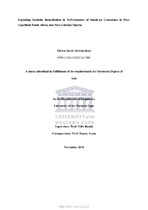| dc.description.abstract | This research has been conducted by focusing on the trajectories of semiotic ensembles from
various contexts that stand-up comedians exploited for aesthetic and communicative
purposes. I apply the social semiotic theory of multimodality (Kress and van Leeuwen, 2001,
2006), and the notions of semiotic remediation (Bolter and Grusin, 1996, 2000) and
resemiotization (Iedema, 2003) to selected audiovisual recordings performances of Trevor
Noah and Loyiso Gola from South Africa; and Atunyota Akporobomeriere (Ali Baba) and
Bright Okpocha (Basket Mouth) from Nigeria. I explore the trajectories of semiotic resources
that the comedians used across modes, contexts and practices. I also trace the translation and
interpretation of socio-cultural and political materials by South African and Nigerian stand-up
comedians’ performances. The idea is also to examine the extent to which the socio-cultural
and political contexts of both countries have differential effects on the choices in the semiotic
resources used in the reconstruction of meanings, including cross socio-cultural taboos. The
study reveals that combinations of various semiotic materials ranging from political, sociocultural,
religious and personal lifestyles are remediated (repurposed) for comic and aesthetic
effects. This involves translating and re-interpreting the semiotic resources across contexts
and practices. In this regard, the study showed how the artists rework verbal language,
images, socio-political discourses and other semiotic material for new meanings. It also
reveals that although the choices of materials are similar, there is a tendency of localizing
semiotic resources to particular localities and audiences, so that each artist’s performance
comes out as unique to the person. The study concludes that language alone is not at the core
of communication as other semiotic modes (in addition to languages) are integrated
interweaving resources to make meaning. The direction of the modes or resources is
multidimensional. All the spoken texts, all the non-linguistic modes: gestures, stance,
movements, running on stage, postures, mimicking and others, perform vital roles to recontextualize
meanings in stand-up comedy performance. Therefore, the study opens up new
perspectives on social semiotic approaches to multimodality, as well as on language social
semiotic and to theory and media studies. The contribution also answers the call to expand
the understanding and research on the theory of ‘multimodality’ and the various concepts
such as semiotic remediation and resemiotization associated with it. | en_US |

